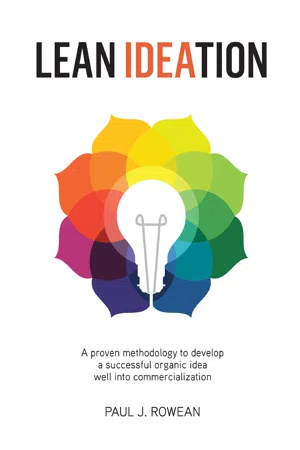
Lean Ideation
A Proven Methodology to Develop a Successful Organic Idea Well into Commercialization
- 166 pages
- English
- ePUB (mobile friendly)
- Available on iOS & Android
Lean Ideation
A Proven Methodology to Develop a Successful Organic Idea Well into Commercialization
About This Book
Seventy percent of all new products introduced in the USA fail and are taken off the market within three years. And these failures come from large companies, many of which are Fortune 500 and advertise with Super Bowl TV commercials. There are a number of reasons these products fail, but perhaps the most common is the lack of or ignoring of the Voice of the Customer research.LEAN IDEATION is a step by step process of developing an idea, including finding the idea if none exists, through commercialization and into the first three years of the product life.. The goal is to have a team of people help their company move into the 30% successful range on new products.The process in LEAN IDEATION was developed by studying and focusing on two key fronts: 30 years of new product development and the study of and implementation of the Toyota Production System. Anyone involved with new product development will benefit from reading LEAN IDEATION.
Frequently asked questions
Information
- A high failure rate because - inadequate preparation (no research question), no Voice Of the Customer (VOC) and no burrowing into market segmentation.
- While they think they do, manufacturers don’t truly understand their customers (when we say “customers” we mean end users) and their problems.
- Engineering and marketing each have a view held unto themselves of understanding the customer needs.
- A lack of clarity or a gap exists between what marketing wants for a design and the program designers view. No fact based information.
- The less we understand about the customer the more we try to make up for it by enriching the feature set (this issue is one of the seven lean wastes to be discussed later in the Toyota Production System)
- Lack of consensus on what to do between internal functional groups. We can overcome this issue by forming a team and giving them a mission.
- This failure is really big- No effective method for making engineering trade offs. This is a problem that can plague new product development through and well into commercialization. What is happening here is each time a problem or issue surfaces the team solves iit by moving further away from what the customer told us they wanted and/or needed. By the time commercialization arrives what is brought to market is clearly headed for failure because it is so far off track. We can overcome this by making Quality Function Deployment (QFD) or the House of Quality a critical measure as the product is developed. What happens here is the QFD chart is available at all team meetings and should one of the five “critical to quality” measurements be off course the project immediately stops and corrective actions are put into place to bring it back to the original measure. This subject is so important that we dedicate nearly an entire chapter to QFD. More on this later.
- Inability of the team to deem a project undesirable and explain to management why they want to abandon the project. “Killing” a product project is considered weak yet team members must not ignore the caution lights and become a statistic of the 70% of new products failing within three years of launch.
- CEO says “We are consistently late to market”
- “And when we finally get there, costs are off target and sales miss plan -just can’t count on them”
- “We often release tooling before the design is final”
- “The customers view our new products program as lackluster and tired”
- CEO says “Our engineers, while talented, have never spoken to or visited a customer about fit, form and function of our product”
- CEO says “A gap exists between sales and design engineering each have their own opinion of what the customer wants”
- CEO says “Our current new product funnel sales expectations are not strong enough to meet future sales objectives and profit plans”
- CEO says “Reading our new product launch plan is better than taking two sleeping pills”
Table of contents
- Chapter 1
- Chapter 2
- Chapter 3
- Chapter 4
- Chapter 5
- Chapter 6
- Chapter 7
- Chapter 8
- Chapter 9
- Chapter 10